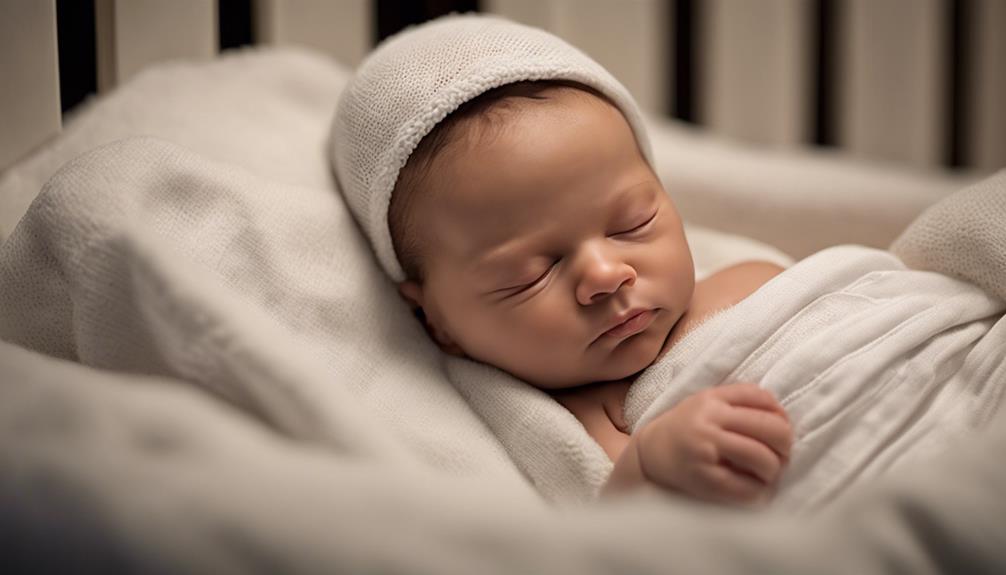While it's natural to want to hold our newborns all the time, some may argue that the held-only habit is essential for bonding and comforting the baby.
However, have you ever wondered if there could be a better way to guarantee both your baby's comfort and your sanity?
Let's explore how breaking the held-only habit through gentle sleep training techniques can lead to more restful nights for everyone involved.
Key Takeaways
- Transition gradually from held-only sleep to promote independent sleep skills.
- Encourage diversification of sleep habits for newborns.
- Provide gentle reassurance during the transition to break the held-only habit.
- Foster a secure bond while nurturing independent sleep behaviors.
Understanding the Held-Only Habit
Understanding the Held-Only Habit is important for newborn sleep training as it sheds light on why babies develop a strong preference for being held during sleep. Newborns form this habit because they associate being held with comfort, security, and warmth, mirroring the sensations they experienced in the womb.
The constant movement in the womb conditions babies to seek soothing swaying motions, making them reliant on being held for sleep. When caregivers hold babies, it helps regulate their body temperature, creating a snug environment that enhances their sleep comfort.
Additionally, sudden changes in the sleep environment can startle newborns awake, reinforcing their preference for being held during sleep. Since babies lack self-soothing skills early on, they depend on external soothing measures like being held to fall asleep.
Recognizing and addressing this habit is important in helping newborns learn to self-soothe and sleep independently.
Reasons for Held-Only Sleep

As newborns adapt to the world outside the womb, their preference for being held during sleep stems from a deep-rooted need for comfort and security. In the fourth trimester, babies are adjusting to a whole new environment, and being held provides them with a sense of familiarity and safety.
The constant swaying motions in the womb have made them accustomed to movement, making it easier for them to fall asleep when held. When cradled close, babies can feel the caregiver's movements, listen to their heartbeat, and experience the warmth that mimics the womb, creating a soothing and secure environment for sleep.
Additionally, being held helps regulate their body temperature, ensuring they're comfortable and less likely to be startled awake. Sudden changes in sleep environments can trigger startle responses, leading newborns to seek the reassurance of being held for that added layer of security and comfort they crave during this delicate adjustment period.
Pros and Cons of Supported Sleep

Supported sleep offers newborns a sense of comfort and security during their initial adjustment period. It can create a strong bond between parents and their little ones, fostering a nurturing environment for the child's development. However, while supported sleep has its benefits, it is important to be mindful of the potential drawbacks. Over-reliance on supported sleep may impede the baby's ability to learn independent sleep skills, which are important for their long-term sleep habits. Parents should consider the pros and cons of supported sleep carefully to make informed decisions that align with their parenting goals. Gradually shifting from supported sleep to independent sleep can help strike a balance between providing comfort and encouraging self-soothing abilities. By understanding the dynamics of supported sleep, parents can navigate this stage with confidence and compassion.
| Pros of Supported Sleep | Cons of Supported Sleep | Making Informed Decisions |
|---|---|---|
| Provides comfort and security | May hinder independent sleep skills | Consider long-term sleep habits |
| Strengthens parent-child bond | Potential over-reliance | Balance pros and cons |
| Helps with baby's adjustment | Dependency concerns | Gradual change strategies |
Transitioning to Independent Sleep

Moving from the stage of offering supported sleep to encouraging independent sleep can be a gradual yet rewarding journey for both parents and newborns.
It's crucial to start shifting by introducing one nap a day in the crib while the baby is drowsy but awake. This method helps babies learn to fall asleep independently. Gradually diversifying sleep skills by laying the baby down awake can aid in this shift. Adjusting the order of naptime events, like feeding and soothing, can also play an important role in teaching babies to sleep independently.
During this shift period, offering gentle reassurance, such as holding their hand or placing a palm on their chest, can provide the necessary support. Remember to be patient with the learning curve, celebrating small wins along the way.
With time and consistent efforts, your baby will learn to sleep independently, bringing peace and rest to both you and your little one.
Gentle Sleep Training Techniques

When gently guiding newborns through sleep training, prioritizing comfort and reassurance is crucial to support their shift towards independent sleep. Gentle sleep training techniques offer a nurturing and responsive way to help your baby learn to sleep without constant holding.
By taking a gradual approach and providing consistent soothing alternatives, you can ease your little one into independent sleep while still offering the comfort they need.
These gentle methods avoid harsh approaches like cry-it-out, focusing instead on creating a secure environment for your baby to feel safe and supported as they learn this new skill. Being patient and understanding during this process is crucial, as every baby is unique and may require different levels of reassurance.
Conclusion
To sum up, breaking the held-only habit in newborn sleep training is essential for establishing healthy sleep habits. While it may be challenging, moving towards independent sleep is vital for both baby and parents.
Remember, Rome wasn't built in a day, so be patient and consistent in your approach. With gentle techniques and a soothing environment, your baby will soon learn to sleep without being held, leading to peaceful nights for all.










